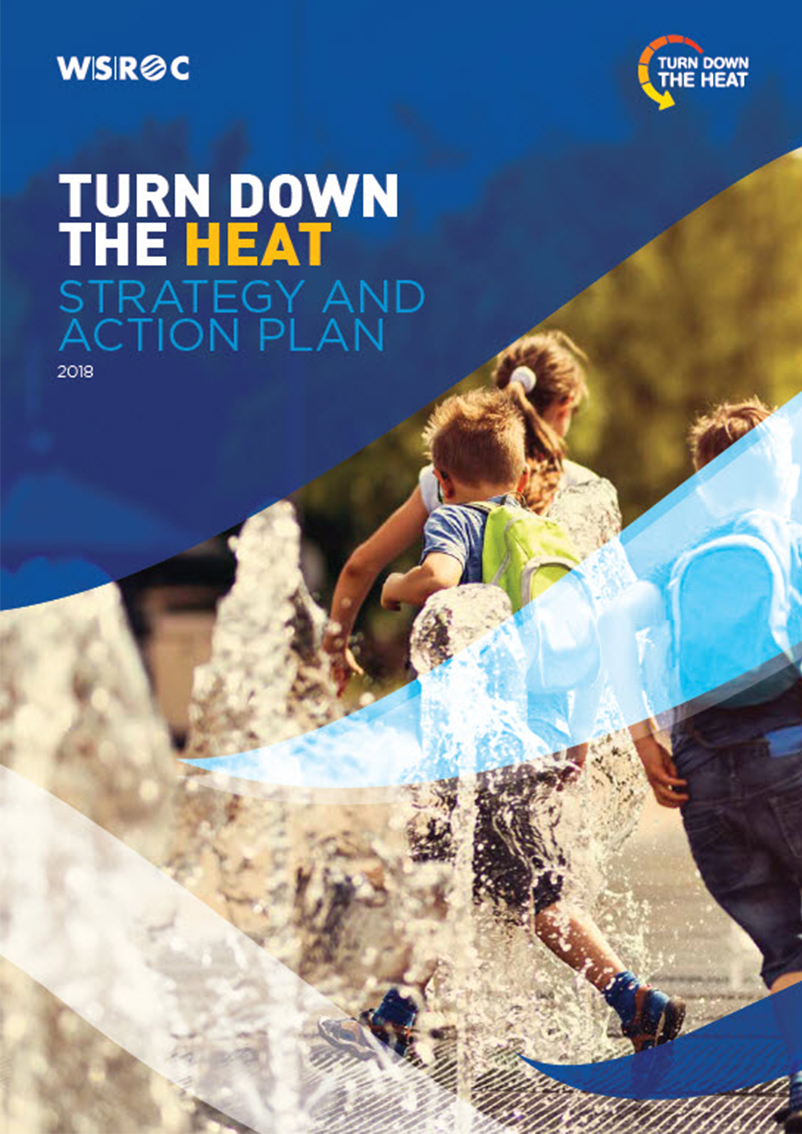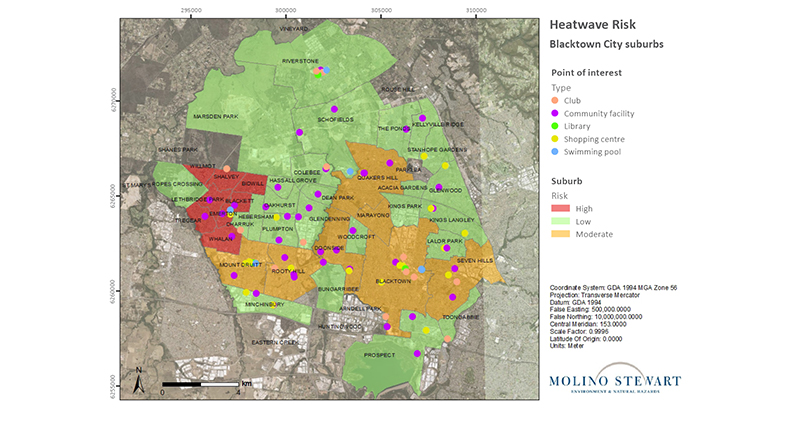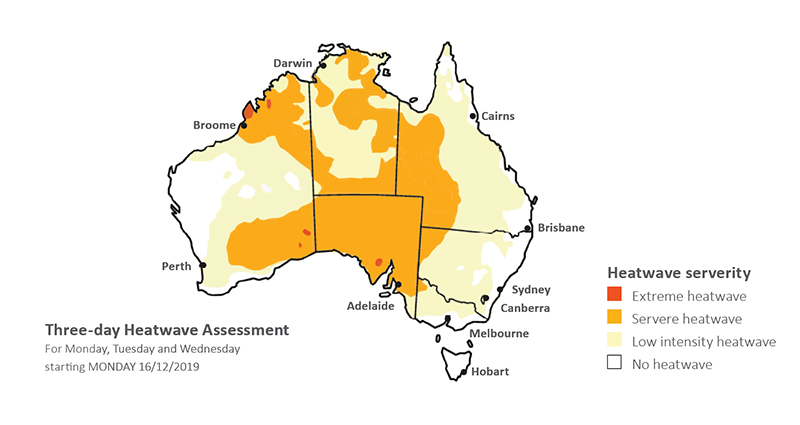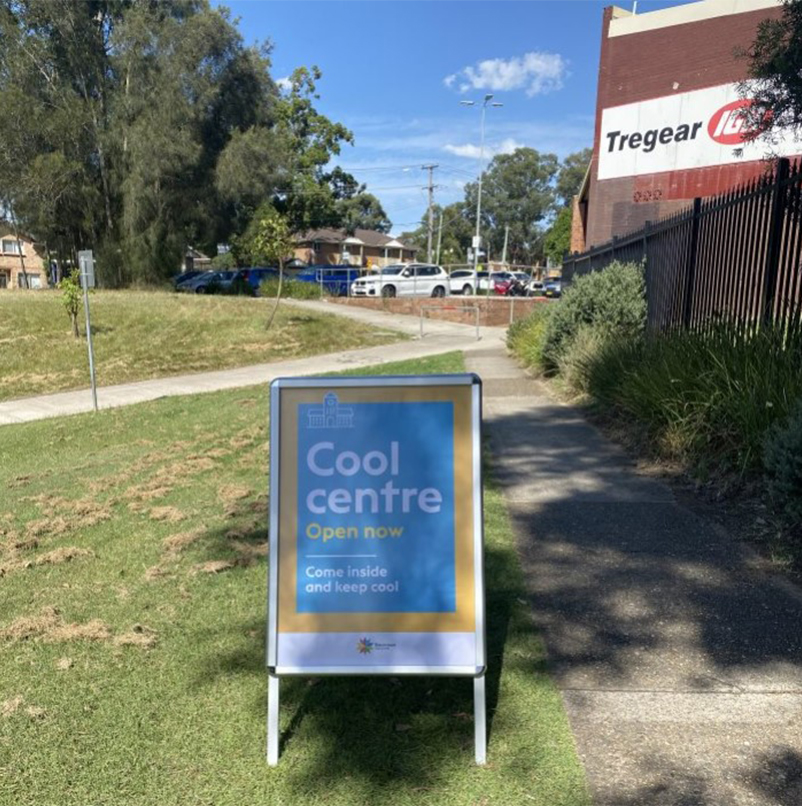Abstract
In Australia, heatwaves are more deadly than any other natural hazard and predicted to increase in frequency and intensity as a result of climate change. Heatwaves are directly connected to human health through heat-related illnesses such as heat exhaustion and heat stroke. Vulnerable people, particularly those without effective cooling in their homes, are at high risk of illness or death during heatwaves. Heat refuges—typically air-conditioned or cooled buildings that have been designated as a site to provide respite and safety during extreme heat—are commonly used in the Northern Hemisphere for vulnerable people during heatwaves but are less prevalent in Australia. In Australia, heat refuges tend to be managed by local councils as part of local planned climate adaptation measures. This article discusses the development of a heat refuge strategy in Blacktown City Local Government Area in western Sydney. Blacktown City has higher summer average temperatures than coastal Sydney, caused by its local geography and urban heat island effects that limit the inflow of cooler coastal winds. The draft Blacktown City heat refuge strategy is based on some of the key components of disaster risk reduction including risk assessment, early warning systems, emergency management planning, evacuation centres and community participation.
Introduction
At the global scale, the number of hot days and nights has increased since the 1950s, while cold days and nights have decreased (Seneviratne et al. 2012). According to the Sixth Assessment Report of the Intergovernmental Panel on Climate Change (IPCC), this trend will continue ‘until at least the mid-century under all emissions scenarios considered’ (IPCC 2021). Many changes in the climate system become larger in direct relation to increasing global warming. They include increases in the frequency and intensity of hot extremes and heatwaves (IPCC 2021).
There is no universal definition of a ‘heatwave’. For example, the World Meteorological Organization (2018) defines heatwave as:
A period of marked unusual hot weather (maximum, minimum and daily average temperature) over a region persisting at least three consecutive days during the warm period of the year based on local (station-based) climatological conditions, with thermal conditions recorded above given thresholds.
In contrast, in Australia, a heatwave is defined as ‘three or more days in a row when both daytime and night-time temperatures are unusually high in relation to the local long-term climate and the recent past’ (Bureau of Meteorology 2021a). In common is that a heatwave is an unusual period of extended hot weather.
Heatwaves in Australia have intensified in the recent past and are projected to increase faster in the future. According to Trancoso and co-authors (2020), ‘Heatwaves have increased in intensity, frequency and duration across Australia over the past 67 years, such intensification was particularly higher in recent decades.’ Heatwaves may be 85% more frequent in Australia and may last up to one month if global warming increases from 1.5 to 2.0°C (Trancoso et al. 2020).
Heatwaves are directly connected to human health through heat-related illnesses (e.g. heat exhaustion, heat syncope and heat stroke) and death, with people’s risk highly dependent on their exposure, location and susceptibility. Physiological factors (e.g. age, gender, pre-existing illness and medication or drug use) and behavioural or contextual factors (e.g. employment, activity, clothing, income and housing type) are determinants for heat-related illness and death (Ebi et al. 2021).
Heatwaves are by far the most lethal extreme weather risk in Australia. Since 1890, heatwaves have killed more people in Australia than bushfires, cyclones, earthquakes, floods, and severe storms combined (Deloitte 2017). In Victoria, in early 2009, the heatwave that preceded the Black Saturday bushfires resulted in 374 more deaths than would otherwise be expected (excess deaths), while 173 people perished in the fires themselves (State of Victoria 2009). According to Longden and co-authors (2020):
National mortality records in Australia suggest substantial under-reporting of heat-related mortality. Less than 0·1% of 1·7 million deaths between 2006 and 2017 were attributed directly or indirectly to excessive natural heat. However, recent research indicates that official records underestimate the association at least 50-fold.
Reducing risks to health from current and projected heatwaves depends on physiological acclimatisation and also on planned adaptation by public health officials in concert with partners in other sectors (Ebi et al. 2021). This article discusses the development of a heat refuge strategy as part of planned climate adaptation by Blacktown City Council.
Heat refuges
Public heat refuges are provided by governments and other organisations in countries around the world. For example, in the USA, heat refuges are called ‘cooling centers’ or ‘cooling shelters’. They are defined by Widerynski and co-authors (2017) as a:
...location, typically an air-conditioned or cooled building that has been designated as a site to provide respite and safety during extreme heat. This may be a government-owned building such as a library or school, an existing community center, religious center, recreation center or a private business such as a coffee shop, shopping mall, or movie theatre.
Although heat refuges are widely used in Northern Hemisphere countries, they are less prevalent in Australia. This could be because of the relative homogeneous wealth (and therefore perceived universal access to air conditioning and other effective cooling) and consistent hot summer days (compared with more dramatic temperature changes leading to Northern Hemisphere heatwaves). Heat refuges are not included in Australian state and territory heatwave emergency management plans, although the Victorian State Emergency Response Plan Extreme Heat Sub-Plan (Victorian Government 2017) mentions the option for local councils to prepare ‘cool public environments’.
In Australia, heat refuges tend to be managed by local councils as part of local planned heatwave adaptation measures. In Victoria, state government heatwave guidelines for local councils (Victorian Department of Human Services 2009) have been developed and include:
- identify and promote safe, public places during heatwaves that are air-conditioned, such as libraries or movie theatres
- establish cooling centres in air-conditioned council buildings or use mobile air conditioning units.
Some local councils provide heat refuges by extending the opening hours of their air-conditioned facilities including libraries and providing free shuttle buses to and from local swimming pools.
However, heat refuges can be viewed as a ‘maladaptation’. Maladaptation is the concept of a treatment or adaptation becoming more harmful then helpful (Juhola et al. 2016). While air conditioners used in heat refuges may provide immediate health benefits, they also contribute to greenhouse gas emissions if they are using fossil fuels to provide the cooling. However, this perception will become less valid as Australia increases its uptake of renewable energy (Clean Energy Council 2021).
Although not greatly used throughout Australia, there is a strong case for the use of heat refuges during heatwave emergencies particularly in areas that experience marked urban heat island effects (i.e. the large cities) and those that have significant vulnerable populations.
Heatwaves in Blacktown City
Blacktown City is located in north-west Sydney and is home to approximately 403,000 people. It is a city of diverse cultures and represents around 188 birthplaces and 182 different languages (Blacktown City Council 2021).
Western Sydney, including Blacktown City, has higher summer average temperatures than coastal Sydney. This is caused by local geography and urban heat island effects that limit the inflow of cooler coastal winds (NSW Office of Environment and Heritage 2019). The temperature difference between western and coastal Sydney has been increasing over the past several decades and is projected to increase under climate change (NSW Office of Environment and Heritage 2019). Blacktown City is expected to experience an additional 5 to 10 extremely hot days (over 35°C) per year by 2030 (NSW Office of Environment and Heritage 2019).
At the same time, its population is growing rapidly, meaning more people are exposed to heatwave risks. In addition, Blacktown City has a relatively large proportion of vulnerable people compared with other NSW local government areas (Australian Bureau of Statistics 2016). Vulnerable groups include:
- the elderly
- those with underlying chronic health issues
- people with disability
- those with addiction issues
- people experiencing homelessness
- Aboriginal and Torres Strait Islander peoples
- people from culturally and linguistically diverse (CALD) backgrounds.
For these groups, access to effective cooling can be difficult during heatwaves in western Sydney. There is also a high correlation between low socio-economic status and not having air conditioning or other suitable cooling devices (e.g. fans) in homes. Of particular concern are renters and people in social housing (Zografos et al. 2016).
The Western Sydney Regional Organisation of Councils (WSROC), of which Blacktown City Council is a member, developed the Western Sydney Turn Down the Heat Strategy in 2018 (WSROC 2018). This was developed to increase awareness and facilitate a coordinated response to the diverse challenges of urban heat in western Sydney.

The Western Sydney Turn Down the Heat Strategy (2018) increased awareness and facilitated a coordinated response to urban heat.
The Turn Down the Heat Strategy aims to:
- identify and leverage existing best practice to develop a program of effective actions at the household, precinct and regional levels
- acknowledge the limitations of the current policy framework with regard to urban heat to galvanise action across diverse stakeholders
- propose a series of priority actions for development with a broader stakeholder group.
Action 11 in the strategy involves a ‘preventative heat response framework that focuses on protecting the vulnerable and connecting communities’ of which a network of heat refuges could be a part.
Developing the heat refuge strategy
In February 2020, Blacktown City Council declared ‘we are in a state of climate emergency requiring immediate action by all levels of government’ (Blacktown City Council 2020). Council identified the use of heat refuges as part of its climate change policy. It developed and is implementing its Responding to Climate Change Policy (Blacktown City Council 2018) that includes a suite of planned climate adaptation measures. Commitment 3 in the policy is: ‘Assist our community to reduce greenhouse gas emissions and build resilience to climate change’. Action 3d in the accompanying strategy is: ‘Develop a strategy for enabling Council-owned public amenities to provide refuges from extreme heat for vulnerable residents’.
In 2019, Blacktown City Council engaged consultants Molino Stewart Pty Ltd to develop a heat refuge strategy for the city. The draft strategy reflects 5 components of disaster risk reduction as advocated by the Sendai Framework for Disaster Risk Reduction 2015–2030 (United Nations 2015) and Australia’s National Disaster Risk Reduction Framework (Australian Government 2018). The 5 components are:
- risk assessment
- early warning systems
- emergency management planning
- evacuation centres
- community participation.
Risk assessment
A risk analysis was conducted to identify the parts of Blacktown City with the most vulnerable populations to heatwave and those that may not have access to air conditioning. This analysis identified high-risk parts of Blacktown City to which the establishment of heat refuges should be prioritised.
The NSW Heat Vulnerability Index (HVI) dataset (NSW Department of Planning, Industry and Environment 2016) identified areas to monitor where populations in the Sydney Greater Metropolitan Area are more vulnerable to the adverse effects of urban heat (as at summer 2015–16). The HVI uses indicators for exposure, sensitivity and adaptive capacity to calculate an overall heat vulnerability index.
In the risk assessment, the following demographic attributes were added to the existing HVI social vulnerability indicators relating to population density, the elderly, the very young and persons needing care:
- Socio-economic disadvantage. There is a high correlation between the lack of effective cooling in homes and low socio-economic status.
- People not fluent in English. One of the vulnerable groups is people from CALD communities as they may have low socio-economic status and new arrivals may not have developed social support networks.
- Aboriginal and Torres Islander peoples are potentially vulnerable with some having low socio-economic status.
Households without a car could face barriers to accessing existing cool places. - Families with one parent. This may inhibit children accessing cooling as the parent may be working, and also, they may reflect low-socio-economic status.
- Single, older people (over 65 years) may be highly vulnerable due to mobility issues and possible lack of social networks.

Figure 1: Map of Blacktown City showing the risk of people not being able to access home cooling.
As a result of the analysis, Figure 1 shows the high-risk areas (vulnerable populations with potential limited access to effective cooling in heatwaves) in Blacktown City. The high-risk areas are located in the western part of Blacktown City and include the suburbs of Lethbridge Park, Whalan, Bidwill, Willmot, Shalvey, Tregear, Emerton and Blackett. The risk trend shown in Figure 1 is further exacerbated by the average gradation of heat from cooler in the east to hotter in the west (Western Sydney University 2020).
Potential heat refuges such as libraries, swimming pools, community facilities, shopping centres and clubs are also shown in Figure 1. The map shows that the main potential heat refuges within the high-risk areas were community facilities such as community halls and hubs.
Early warning systems
Critical to the activation of heat refuges is an early warning system that provides advice regarding impending heatwaves. The Australian Bureau of Meteorology provides heatwave forecasts for a region 3 days prior to the possible heatwave. Heatwaves are classified into 3 types, based on intensity:
- Low-intensity heatwaves are more frequent during summer. Most people can cope during these heatwaves.
- Severe heatwaves are less frequent and are likely to be more challenging for vulnerable people such as the elderly, particularly those with medical conditions.
- Extreme heatwaves are rare. They are a problem for people who do not take precautions to keep cool; even for people who are healthy. People who work or exercise outdoors are at greater risk of being affected.
The Bureau of Meteorology heatwave service provides assessments that identify heatwaves in the preceding days and heatwave forecasts that predict those about to occur. The heatwave assessment consists of 2 maps (see Figure 2) for the 2 previous 3-day periods. Each map shows the location of heatwave conditions and the level of intensity.
For Blacktown City, the forecast of ‘severe’ and ‘extreme’ heatwaves will trigger activation of the emergency management arrangements related to the Blacktown City heat refuge strategy. An indication of impending heatwave is provided through 7-day forecasts for western Sydney (Penrith) issued by the Bureau of Meteorology.
Emergency management planning
The NSW Government recognises heatwave as part of its emergency management planning. The State Heatwave Subplan (NSW Government 2018) is a subplan of the NSW State Emergency Management Plan. The State Heatwave Subplan details ‘the control and coordination arrangements for aspects of the preparation for, response to and immediate recovery from a heatwave’.
The subplan primarily provides warnings to heatwave-affected communities and educational advice for people to respond to heatwave emergencies. It does not identify nor organise heat refuges as part of the NSW heatwave response and, therefore, the use of heat refuges in heatwave emergencies is primarily managed by local councils.
An emergency management plan was developed as part of the draft Blacktown City heat refuge strategy to cover actions required in the prevention and mitigation, preparedness, response and recovery phases as per the principles of ISO 22320 and the guidance in the Australian Emergency Management Arrangements Handbook (Australian Institute for Disaster Resilience 2019). It is hoped that this emergency management plan is included in the City of Blacktown Local Disaster Plan.

Figure 2: Example of a heatwave-assessment map and text. Source: Bureau of Meteorology (2021b)
Evacuation centres
Heat refuges are essentially evacuation centres to provide respite for people from the effects of extreme and prolonged heat, particularly in their homes. There are 4 components required in a heat refuge service (Widerynski et al. 2017):
refuges are cool, safe, accessible places
transport from either home or a designated pick-up location is offered
volunteers are trained to assist in refuges and can identify heat-related health issues
promotion and advertising of the heat refuge service is conducted prior to and during heatwaves.
The following guidelines were used to identify potential heat refuges in Blacktown City. Heat refuges (other than swimming pools) must have the following attributes:
- air-conditioning
- capacity – venues must have reasonable capacity (e.g. greater than 20 persons) to be worthwhile opening
- seating – must have seating for each person as many will be older and/or disabled
- accessibility – most refuges should be in or near high-risk or moderate risk areas of Blacktown City (see Figure 1) to enable short transport or even in walking distance
- opening hours – should at least be 9am-5pm
- toilets – should be male, female, non-gender and disabled toilets commensurate with the maximum people capacity
- drinking water – should be available and a refrigerator should be available to keep water cool
- facilities for people with disabilities – should be available including wheelchair access ramps, disabled toilets
- drop-off ease – venues should have drop-off zones close to the venue entrance
- COVID-19 plan – venues should have a plan in place and comply with the current COVID-19 restrictions issued by NSW Health.
If possible, heat refuges should:
- be located in high and moderate risk areas
- have activities available (e.g. watch television)
- be housed in a separate room (e.g. in clubs)
- have food available or close by.
A gap analysis was conducted for each type of potential heat refuge identified. The following venues offered the most promise for heat refuges in Blacktown City:
- libraries (council-managed, have all required facilities, are located near high-risk areas)
- community centres and halls (council-managed, some in high and moderate risk areas)
- clubs (have all facilities, some have transport, are located in high and moderate risk areas).
Heat refuges were only assessed for extended day use. However, during a heatwave there is little respite for Blacktown City residents at night if they do not have air-conditioning or other effective cooling devices (Bureau of Meteorology and CSIRO 2018). Overnight heat refuges face several other issues including security, willingness of volunteers to assist, venue insurance and sleeping arrangements. Currently, the Blacktown City strategy only covers heat refuges for extended day use (e.g. 6am-8pm).

The Cool Centre (heat refuge) trial at Tregear Community Centre. Image: Kelsey Sanborn
Community participation
As shown by overseas research (e.g. Widerynski et al. 2017), the heat refuge service will be limited and possibly not effective if it is totally reliant on local government facilities and resources. Thus, there is a need to involve local community service providers and access the social capital (social networks and trust) they possess.
In the drafting of the Blacktown City heat strategy, 36 community service providers that were related to vulnerable groups or could provide heat refuge and transport services were interviewed. These community service providers included:
- local community clubs
- places of worship
- disability services providers
- multicultural services providers
- WSROC
- Western Sydney Local Health District
- seniors’ services organisations
- humanitarian organisations (e.g. Red Cross, Vinnies)
- NSW Police.
The interviews confirmed strong support for the heat refuge concept and several opportunities for heat refuges, transport services and volunteers were identified. The implementation of the Blacktown City heat refuge strategy will rely on the collaboration of the council and the range of community service providers.
Conclusion
The Blacktown City heat refuge strategy is based on the same emergency management principles as other natural hazards such as floods, bushfires and cyclones. The cumulative effects of multiple-hazard events should be acknowledged in local emergency management planning noting that during heatwaves other events could be prevalent such as bushfires and drought. The ongoing consequences of future pandemic restrictions are also recognised in the heat refuge strategy.
The conceptual framework for the strategy is transferable to other local government areas, particularly those with significant proportions of vulnerable people that may not have access to air conditioning and other forms of cooling.
Practical aspects of the strategy were trialled during the 2021–22 summer and the strategy was finalised based on evaluation of these trials. It is envisaged that the strategy will be refined from learnings identified after each heatwave event.


